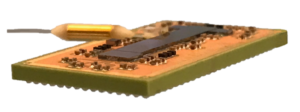Discussion with Chris Doerr, Associate Vice President, Advanced Development at Acacia Communications

Advancements in silicon photonics are changing the optical networking industry. That change is in part fostered by the discussions and learning that happens at industry events. Chris Doerr, Ph.D., Associate Vice President of Advanced Development at Acacia, recently co-chaired the 15th International Conference on Group IV Photonics in Cancun, Mexico where they discussed the hottest silicon photonic trends. We asked him a few questions about the conference and the content he helped guide.

Q: You recently co-chaired the Group IV Photonics conference. Can you share some background on the event and your role there?
Chris: I co-chaired the event with Milos Popovic from Boston University and helped set the agenda and recruit speakers for the three-day conference. The Group IV Photonics conference is an academically-driven industry conference that hosted approximately 90 attendees in Cancun this year. It is intended to deliver insights on current and future innovations in regards to photonics and to facilitate discussion among colleagues in the field. Representatives from companies like Intel, IBM and HP gathered alongside university experts from MIT and University of California – Santa Barbara for a single-session conference that encouraged open and honest conversation on industry’s latest innovations and challenges.
Q: What was the key theme of the Group IV Photonics conference?
Chris: We identified two core areas we wanted to address through session topics and plenary discussions at the event. The first addressed electronic-photonic integration. This essentially means identifying the best methods for integrating photonics. What was once seen as too expensive for wide adoption is now receiving renewed attention from companies. They are interested in uncovering best practices such as, how do you integrate electronics and photonics? Do you use the same chip, or do you co-package? Acacia demonstrated co-packaged optics and electronics on a ball-grid-array package last year.

The second plenary discussion was on a very hot topic at the moment – neuromorphic computing, which can be used for deep learning. We’re starting to see this technology applied to advanced technology, such as self-driving cars. For instance, it’s impractical to have a supercomputer in your car, but in order for self-driving cars to become commonplace, they need to be equipped with technology can differentiate between a person and a mailbox. Neuromorphic computing can do this faster, with a smaller computer and with less power.

Q: Why are conferences like Group IV Photonics so important to the future of the industry?
Chris: I’ve found that at these smaller industry conferences there is less noise to break through. Participants are more comfortable expressing their opinions and having open dialogues about what they are seeing and doing than they typically are at larger trade show events. These intimate events are better suited to candidly address industry-wide issues and other topics that might feel too sensitive to bring up at a larger conference where media and analysts are listening. It is an opportunity to focus on longer term innovations.
Q: How does Acacia and its innovations fit into the future of photonics?
Chris: We see more opportunity for applications of silicon photonics across industries than we did several years ago. The new developments discussed at the conference require more computational power than ever before, meaning more capacity and higher speed, and optical networks are necessary to share processing and information between computers.
Thank you to my co-chair and the rest of the event team for a wonderful conference, and I look forward to next year!
